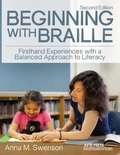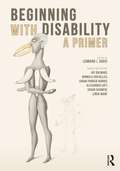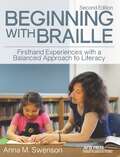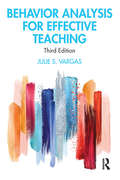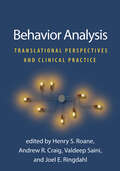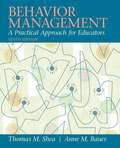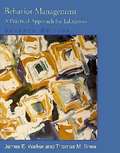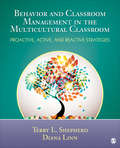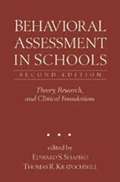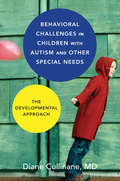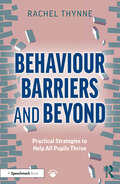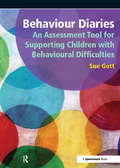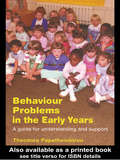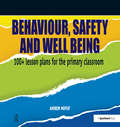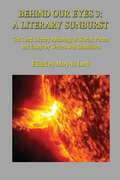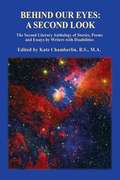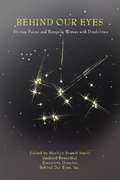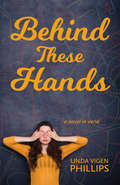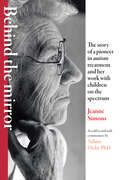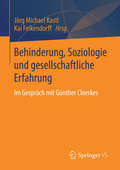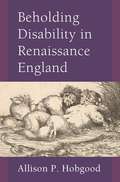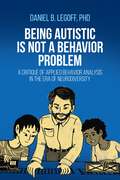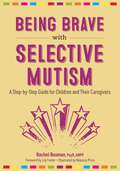- Table View
- List View
Beginning With Braille: Firsthand Experiences With A Balanced Approach To Literacy
by Anna M SwensonBeginning with Braille, the illuminating classic written by a master teacher and beloved by readers in the United States and abroad, has been expanded and revised This exceptional resource that has been an essential guide to helping educators teach braille to readers who are visually impaired contains invaluable new sections on a range of critical topics, including trends in general education literacy instruction and the teaching of braille, working with dual-media learners, and addressing diverse needs effectively. Updated with UEB, the second edition also includes new teaching materials, record forms, and braille activities.
Beginning With Disability: A Primer
by Lennard DavisWhile there are many introductions to disability and disability studies, most presume an advanced academic knowledge of a range of subjects. In Beginning with Disability, Lennard Davis has put together the first introductory reader for disability studies aimed at first- and second-year students in two- and four-year colleges. This volume of essays across disciplines including education, sociology, communications, psychology, social sciences, and humanities features accessible, readable, and relatively short articles that do not require specialized knowledge. Lennard Davis, along with a team of consulting editors, has put together feature a number of blogs, vlogs, and other videos to make the materials more direct and vivid to students. The text includes a section called "Subject to Debate" that features short pro and con pieces on controversial subjects that can be debated in class or act as prompts for assignments.
Beginning with Braille
by Anna M. SwensonWritten by a gifted practitioner, Beginning with Braille offers teachers a variety of practical strategies for designing and delivering braille instruction. This guide emphasizes the balance between a meaning-centered approach and braille reading skills for early literacy and beginning readers and writers, as well as children with multiple disabilities. It provides suggestions for reading aloud to young children, selecting and making early tactile books, and teaching tactile and hand movement skills, as well as tips on the braille writing process. Reading Beginning with Braille, with its numerous suggestions and examples, is like having a mentor by your side.
Beginnings and Blueprints
by Kenneth JerniganThis is a motivational book showing that blind individuals can live productive lives doing the things that sighted people do and even succeed at it!
Behavior Analysis for Effective Teaching
by Julie S. VargasBehavior Analysis for Effective Teaching is a clear, comprehensive book on the integration of non-aversive behavior analysis principles into classrooms and other school settings. Carefully revised and updated throughout, this third edition includes new content on precision teaching and a new chapter on how teachers can provide appropriate education for students with special disabilities who are included in their classrooms. Focused on merging behavior management with effective student instruction and illustrated with examples from real teachers’ experiences, the book is an ideal primary resource for undergraduate and graduate courses in teacher education, special education, school psychology, and school counseling, as well as for preparation toward the BACB Credentialing Exam.
Behavior Analysis: Translational Perspectives and Clinical Practice
by Henry S. Roane Joel E. Ringdahl Andrew R. Craig Valdeep SainiThis is the first comprehensive volume to bridge the gap between the science of behavior and applied behavior analysis (ABA). The book demonstrates how laboratory research informs real-world interventions to facilitate behavior change, and vice versa. Most of the chapters are written by researcher–clinician collaborators, who highlight commonalities and differences in the ways they conceptualize behavior and collect, analyze, and use data. Chapters present translational perspectives on conditioning, reinforcement, extinction, choice, verbal behavior, and more. Ethical considerations in translational research are explored. Training in foundational knowledge is a key requirement for behavior analyst certification, making this a needed resource for current and future ABA practitioners.
Behavior Management: A Practical Approach For Educators
by Thomas Shea Anne BauerLong an established and popular text in its field, Behavior Management: A Practical Approach for Educators successfully balances theory and practice to provide readers with a comprehensive manual for creating a positive, pro-social educational environment in which all children can truly learn and enjoy that learning experience. By presenting both research and the proven practices that developed from that research, the authors are able to fully explain behavior management from four perspectives—behavioral, psychodynamic, biophysical, and environmental—in straightforward, jargon-free prose. At the same time, real-life case studies, classroom techniques, clear examples, and helpful plan designs allow preservice and inservice teachers to easily bring what they have learned into the classroom. The new tenth edition has been revised and rewritten to improve its usability and readability, and includes evidence based practices that have recently been identified. A new chapter on response-to-intervention, and its relationship to functional behavioral assessment has also been added, as well as updated information on designing individualized behavior plans.
Behavior Management: A Practical Approach for Educators
by James E. Walker Thomas M. SheaChild psychology textbook aimed at teachers.
Behavior and Classroom Management in the Multicultural Classroom: Proactive, Active, and Reactive Strategies
by Terry L. Shepherd Diana LinnAddressing the increasing number of culturally and linguistically diverse students in today’s schools, Behavior and Classroom Management in the Multicultural Classroom, by Terry L. Shepherd and Diana Linn, provides general and special education teachers with the knowledge, skills, and strategies to make the proactive, active, and reactive interventions necessary to create a positive classroom environment in which all students can learn. Going beyond the traditional rules and hierarchy of consequences and reinforcements, the book demonstrates how to incorporate basic classroom management plans, functional behavioral analysis, functional behavioral assessments, and behavioral intervention plans into the development and implementation of response-to-intervention and school-wide positive behavior support programs. In every chapter, the authors use real world examples and case studies to explore how language and culture affect students’ responses to behavior and classroom management. Unique chapters cover social skills training and collaborating with families of diverse students.
Behavior and Classroom Management in the Multicultural Classroom: Proactive, Active, and Reactive Strategies
by Terry L. Shepherd Diana LinnAddressing the increasing number of culturally and linguistically diverse students in today’s schools, Behavior and Classroom Management in the Multicultural Classroom, by Terry L. Shepherd and Diana Linn, provides general and special education teachers with the knowledge, skills, and strategies to make the proactive, active, and reactive interventions necessary to create a positive classroom environment in which all students can learn. Going beyond the traditional rules and hierarchy of consequences and reinforcements, the book demonstrates how to incorporate basic classroom management plans, functional behavioral analysis, functional behavioral assessments, and behavioral intervention plans into the development and implementation of response-to-intervention and school-wide positive behavior support programs. In every chapter, the authors use real world examples and case studies to explore how language and culture affect students’ responses to behavior and classroom management. Unique chapters cover social skills training and collaborating with families of diverse students.
Behavioral Assessment in Schools: Theory, Research, and Clinical Foundations (2nd edition)
by Edward S. Shapiro Thomas R. KratochwillA landmark text, this volume systematically addresses the issues involved in developing behavioral assessment strategies for educational--rather than clinical--settings. The theoretical and conceptual underpinnings of widely used assessment methods are discussed, and their strengths and limitations evaluated.
Behavioral Challenges in Children with Autism and Other Special Needs
by Diane CullinaneThis book offers a comprehensive view of behavioral challenges for a child with autism or other special needs from a developmental perspective based on the DIRFloortime® framework. Parents and professionals are guided to understand and improve a child's behavior while also supporting underlying developmental capacities for shared attention, warm engagement, trust, initiative, creative shared problem solving, symbolic and logical thinking, and the development of personal values. The approach is presented in three parts. Step-by-step, clinicians, caretakers, and educators will learn how to use the developmental approach to:1. Understand the many variables involved in the behavior of a child with special needs,2. Effectively respond to a challenging behavior in the moment with three key steps: attune, help, and recover3. Create a long-term plan to support developmental and behavioral progress. When a child with a disability has a behavioral challenge, a clinician is confronted with the complexities of the child's developmental strengths and vulnerabilities, individual differences, and his or her unique pattern of interactions in personal relationships. Keeping all the variables in mind, the developmental approach provides a plan that supports a child's growth and deepens his or her capacity for perspective and care for others. The framework is based on universal developmental principles, which are effective regardless of the child's particular age or disability. By recognizing a child's developmental level of functioning, an adult can select strategies to effectively guide the child toward higher levels of relating, thinking and communicating. Through the process of compassionate attunement, and building on a child's strengths, adults can optimistically chart a clear path to long-term success. A refreshing alternative to rewards-and consequences-based models of behavior management, the methods and practices in this book will empower any adult who interacts with a child with special needs, whether their work is directly focused on improving behavior, or because they must provide support so that the child can participate in other endeavors.
Behaviour Barriers and Beyond: Practical Strategies to Help All Pupils Thrive
by Rachel ThynneThis practical resource helps school staff to reframe behaviour as a means of communicating a need, ensuring they can sensitively and effectively support children with a range of Social, Emotional and Mental Health (SEMH) needs and Special Educational Needs and Disabilities (SEND). With case studies and examples woven throughout, the book focuses on relational and strength-based approaches to improve mental health and wellbeing, self-esteem, sense of safety and, in turn, behaviour and educational outcomes. All advice is carefully designed to have the maximum positive impact on the child and minimum impact on teacher time and resources. Key features include: ◾ Accessible explorations of a range of difficulties and their effects on school life ◾ A variety of supportive strategies, tips and advice, designed to be easy to implement effectively within a busy classroom ◾ A focus on building and maintaining positive relationships, making the classroom a safe learning environment Small adjustments can make a huge difference to wellbeing, whether they are for those with a diagnosis, with SEND, with SEMH needs, with anxiety, or just those having a hard time. This book will be an essential tool for teachers, SENCOs and school leaders in both mainstream and specialist settings.
Behaviour Diaries: An Assessment Tool for Supporting Children with Behavioural Difficulties
by Sue GottThe invaluable resource provides a sophisticated technique for teachers to observe, assess, plan and evaluate to improve pupil behaviour. The book recognises the diverse demands of the modern classroom and explores ways in which asking the right question can help in the development of effective solutions. This is far more than ticking check lists as it will: develop a more rigorous approach to the tracking and assessment of behaviour related issues; deepen understanding about biological, psychological and social factors influencing behaviour; give examples of reflective and diagnostic practice, informing planning for successful interventions; and explore ways of collecting appropriate information to support requests for interventions from other agencies. The pack includes a CD ROM with reflective tasks, diagnostic tools, illustrative poems and a staff Powerpoint for professional development sessions.
Behaviour Problems in the Early Years: A Guide for Understanding and Support
by Theodora PapatheodorouAddressing the issue of behaviour problems in the early years, this book offers early years practitioners a practical and well-researched resource covering subjects such as: the nature and extent of behaviour problems in the early years definitions of behaviour problems theoretical frameworks and factors screening and assessment a blueprint for early identification and intervention. This resource is based on the author’s own experience and research in early years practice and she uses a range of practical tips, strategies, activity ideas, forms and checklists to convey her message. Papatheodorou shows that successful early identification and management of behaviour problems requires informed practice that takes into account existing theoretical and conceptual works. All professionals working in an early years environment will find this an invaluable read.
Behaviour, Safety and Well Being: 100+ Lesson Plans for the Primary Classroom
by Andrew MoffattThe new Ofsted framework evaluates the behaviour and safety of pupils at the school. This resource provides over 100 lesson plans promoting: recognition of different emotions and behaviours; practice in responding to those different emotions and behaviours; good behaviour towards, and respect for, other young people and adults. Each lesson plan is linked to a children's book and references SEAL. Lessons can support Literacy, PSHE and citizenship. Lesson plans are bracketed into year groups and five or six-week modules that give schools the opportunity to deliver specific projects on anti-bullying / safeguarding, pupil voice and transition. There are also modules covering emotions such as anger, loneliness, excitement, jealousy, kindness, pride and confidence. This is a comprehensive, accessible and invaluable tool for every classroom.
Behind Our Eyes 3
by Behind Our EyesIn Behind Our Eyes 3: A Literary Sunburst, the third anthology of its kind, six sections comprised of memoirs, fiction, and poetry share slices of life from the perspectives of those living with disabilities. Most works first appeared in Magnets and Ladders, an online literary journal in which novice and experienced writers with disabilities showcase their work. While unique challenges are incorporated into some of the works, this compilation speaks to universal themes and common experiences, involving loss and grief, adversity and fear, love and passion. Subjects such as life-changing illness and the death of a pet are shared with sensitivity and compassion; some works reminding us that a rainbow is possible only in the aftermath of a storm. Heartbreaking, as well as heartwarming, memoirs recount experiences belonging to military veterans, children of immigrants, and parents in the trenches of child rearing. Witty fiction introduces us to cosmic bowling with aliens, and asks us to envision a sky with two moons. Reflective poems describe braille as "ticklish filigree lace on cardboard paper" and fingerspelling that "perform[s] magic in a cacophony of the palms." In other verse, lyrical imagery paints enchanting portraits of the natural world. To unexpected delight, tantalizing recipes accompany several works; such as those for edible salad bowls, lemon herb bread, cinnamon rolls, and even frozen yogurt pops for golden retrievers named Sammy who "sing the blues." As a part of the community myself, I am reminded that the only thing a deaf woman cannot do is hear, and the only thing a blind man cannot do is see. This engaging collection promises three enriching opportunities: readers are challenged to question outdated notions of disability; invited to appreciate perspectives that differentiate us from one another; and encouraged to embrace the threads that make up the fabric of our collective human experience. Readers, disabled and not, will be inspired to hold up a mirror to their own experiences, and recognize that, reassuringly, we are all in this together. --Kelly Sargent, Creative Nonfiction Editor, The Bookends Review and author of Seeing Voices: Poetry in Motion
Behind Our Eyes, a Second Look: The Second Literary Anthology of Stories, Poems and Essays
by Kate Chamberlin Writers Disabilities"Behind Our Eyes: A Second Look" is the second literary anthology by writers with disabilities. The topics range from ridiculously absurd to tragically abusive, from cats and rabbits to guide dogs and even a guiding miniature horse, from medical fiascos to survival tactics, and through pangs of deprivation to heights of success. The vivid tapestry of life these writers weave with their stories, poems, and essays demonstrates what a diverse group of writers they are; yet this tapestry of creative writings showcases how similar they are to each other and to the world. This Behind Our Eyes organization's anthology takes a second look at the intriguing and insightful pieces of sixty-five writers.
Behind Our Eyes: Stories, Poems and Essays by Writers with Disabilities
by Marilyn Brandt SmithLaugh with the blind guy who gets in the wrong car and almost gets arrested. Cry with the little girl whose parents resent her blindness so much that they constantly break her spirit. Rejoice over battles won against burglars, abusive spouses, self-doubt, and health care personnel who keep forgetting their patient can't see. Reflect on the issues of employment, acceptance, independent travel, and the appreciation of nature and other hobbies. This anthology attempts to bridge the gap between how disabled people are viewed by society and how they really live. Read about the writers' workshop, and join the group if you enjoy writing.
Behind These Hands
by Linda Vigen Phillips"A richly woven, unforgettable symphony of feelings and words" –Kirkus Reviews (Starred Review)Piano prodigy Claire Fairchild, 14, has always known music would be her life. So when she has the opportunity to enter a prestigious contest, she goes all in—until she realizes she’s also competing against Juan, a close childhood friend and one of the most talented musicians she knows. It doesn’t help that her thoughts about him are turning romantic.When Claire and her family receive a devastating blow from Batten disease, her world enters a tailspin. Claire decides her musical goals no longer seem relevant.She can’t reconcile the joy that music would bring to her life while her brothers succumb to an early and ugly death. Her decision puts everything at risk: her friendship with Juan, her parents’ expectations, and her own happiness.After Claire accompanies a friend on a school newspaper assignment, she meets a centenarian with a surprising musical past and only one regret in life. Claire knows something in her life has to change before it’s too late, but she’s not sure she has the courage to take the next step.
Behind the Mirror: The Story of a Pioneer in Autism Treatment and Her Work with Children on the Spectrum
by Jeanne Simons Sabine OishiThe life story of Jeanne Simons, whose own autism informed her pioneering work with autistic children.Jeanne Simons devoted her career as a social worker and educator to the study, treatment, and care of children with autism. In 1955, she established the Linwood Children's Center in Ellicott City, Maryland, one of the first schools dedicated to children with autism. Her Linwood Model, developed there, was widely adopted and still forms the basis for a variety of autism intervention techniques. Incredibly—although unknown at the time—Jeanne was herself autistic. Behind the Mirror reveals the remarkable tale of this trailblazer and how she thought, felt, and experienced the world around her. With moving immediacy, Jeanne tells her life story to developmental psychologist, friend, and collaborator Sabine Oishi. Jeanne's unique experience is supplemented by commentary from Dr. Oishi, who explains the importance of key biographical details and fills in additional information about the diagnosis and treatment of autism. Enhanced with a photo gallery, a look at new approaches to the education of children with autism, and a history of Linwood since its founding, the book also contains a foreword, an afterword, and an appendix by James C. Harris, MD, the past director of child psychiatry at Johns Hopkins University School of Medicine and the founder of its autism clinic. Demystifying the experience of autism, Behind the Mirror is a groundbreaking account of possibilities and hope.
Behinderung, Soziologie und gesellschaftliche Erfahrung: Im Gespräch mit Günther Cloerkes
by Jörg Michael Kastl Kai FelkendorffGünther Cloerkes ist einer der wichtigsten europäischen Vertreter einer interaktionistischen Soziologie der Behinderten. Im Zentrum des Bandes stehen Gespräche und Interviews, die Kai Felkendorff und Jörg Michael Kastl mit ihm in den Jahren 2009-2013 geführt haben. Sie werden ergänzt durch Aufsätze von Günther Cloerkes und Jörg Michael Kastl, die historische und systematische Aspekte einer sozial engagierten Soziologie der Behinderten und der Behinderung beleuchten.
Beholding Disability in Renaissance England (Corporealities: Discourses Of Disability)
by Allison P. HobgoodHuman variation has always existed, though it has been conceived of and responded to variably. Beholding Disability in Renaissance England interprets sixteenth- and seventeenth-century literature to explore the fraught distinctiveness of human bodyminds and the deliberate ways they were constructed in early modernity as able, and not. Hobgood examines early modern disability, ableism, and disability gain, purposefully employing these contemporary concepts to make clear how disability has historically been disavowed—and avowed too. Thus, this book models how modern ideas and terms make the weight of the past more visible as it marks the present, and cultivates dialogue in which early modern and contemporary theoretical models are mutually informative. Beholding Disability also uncovers crucial counterdiscourses circulating in the English Renaissance that opposed cultural fantasies of ability and had a keen sensibility toward non-normative embodiments. Hobgood reads impairments as varied as epilepsy, stuttering, disfigurement, deafness, chronic pain, blindness, and castration in order to understand not just powerful fictions of ability present during the Renaissance but also the somewhat paradoxical, surprising ways these ableist ideals provided creative fodder for many Renaissance writers and thinkers. Ultimately, Beholding Disability asks us to reconsider what we think we know about being human both in early modernity, and today.
Being Autistic is Not a Behavior Problem: A Critique of Applied Behavior Analysis in the Era of Neurodiversity
by Daniel B LeGoffApplied behavior analysis (ABA) has become a widely used form of therapy for autistic children without its theories and methods being well understood. This critical analysis of the theories and research on which ABA bases its claim to being an evidence-b
Being Brave with Selective Mutism: A Step-by-Step Guide for Children and Their Caregivers
by Rachel BusmanIf you've picked up this book, talking is probably pretty hard for you. Maybe you really want to talk but feel too nervous to do it when lots of eyes are on you. Perhaps you can talk to certain people but not others or you can only speak a few words in a soft voice. No matter what you are going through, the tips and activities in this book can help you to feel braver about talking.Selective mutism can be tricky to manage. This workbook helps you and your child formulate a plan for exposure activities, and breaks down talking into attainable steps. It includes examples of games to play while practicing talking and offers sample dialogues to illustrate how to do exposures. Pairing a system of rewards along with the exposures helps your child through the challenge of dealing with those uncomfortable feelings. It discusses different situations and places where talking can be difficult and introduces two children, Emily and Jackson, who are both working hard to tackle their selective mutism.Packed full of activities, worksheets and helpful strategies, this book makes putting in the work of being brave around talking fun!
